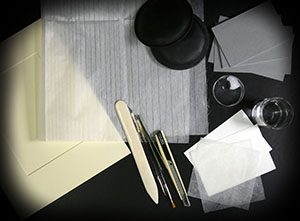
This video shows the whole process of hinging artwork using the T-hinge method to attach art to a mounting board prior to framing.
This is a conservation quality mounting project and uses high quality acid-free materials.
It's important to select the right materials for your mounting project to ensure that artwork is not damaged by the hinges, adhesive etc. and that the hinges can be removed in the future without causing any harm. The risk of using the incorrect materials in your framing project could permanently harm your artwork, presenting issues such as; causing staining/discolouration, weakening the paper, art moving/creasing/buckling in frame, not being reversible/removeable.
The full list of materials used are listed below the video and all are available from our website
 Materials & Tools used:
Materials & Tools used:
The hinging tissue used is available from PEL and has predefined tear-lines which you will see in the video. There are other tissues and pre-cut tapes that are also suitable for the same hinging method which do not have tear-lines.
You can browse our full range of mounting materials here:
Video captions - key stages
- Required tools & materials; Blotting paper, Non-woven Polyester (Bondina), Wheat Starch paste adhesive, Japanese hinging paper, Weights, Bone folder, Tweezers, Knife, Brush
- 00:05 (mins/seconds) - Select the appropriate width of the hinging tissue
- 00:11 - Place weights onto the hinging tissue and apply moisture along the tear line using a brush
- 00:22 - This Japanese tissue has pre-defined tear lines. Alternative tissues may not, but can be torn in a similar way requiring a little more care
- 00:41 - Holding the hinging tissue between thumb, forefinger and middle finger, gently pull the tissue away from tear along the line
- 01:06 - Cut the hinges to the correct length. To make two T hinges, four strips of paper are required
- 00:01:27:14 - 00:01:31:37
Lay the item face down and decide where the hinges are to be attached
- 01:39:33 - There is a rough side and a smooth side to Japanese paper. Choose your preferred side to apply the adhesive
- 01:57 - To the first strip of each T hinge, brush adhesive in the direction of the fibres. Apply the adhesive over approximately half the length of the strip
- 02:25 - It's recommended to place a weight onto the item to hold it in place
- 02:33 - Carefully lift the strip with tweezers and place it onto the area to which it should be attached
- 03:01 - Place a piece of bondina over the strip and lightly burnish with a bone folder for adhesion
- 03:31 - Place sheets of blotting paper over the top of the bondina
- 03:40 - Place a weight onto the blotting paper and leave to dry
- 03:50 - Once the strip is dry, remove the weight, the blotting paper and the bondina. Check the strips are dry
- 04:25 - Once the item is properly positioned, place a sheet of non-woven polyester and a weight onto the item to hold it in place
- 04:43 - Place the non-stick material on top of the item. Fold the strip back and apply adhesive to the other side
- 05:16 - Carefully release the strip from the non-stick material and attach the adhesive side to the backboard
- 05:45 - Place a piece of Bondina (non-woven polyester) over the strip and lightly burnish with a bone folder for adhesion
- 06:19 - Place a weight onto the blotting paper and cardboard and leave to dry
- 06:30 - Once the strip is dry, remove the weight, the cardboard, the blotting paper and the polyester
- 07:03 - Check the strip is dry
- 07:19 - Apply the adhesive to the second strip
- 07:46 - Carefully lift the strip with tweezers and place at ninety degrees to the first to form a T-shape hinge
- 08:21 - Repeat the procedure for each hinge as required